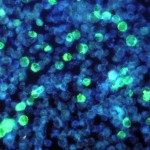Lien vers Pubmed [PMID] – 17559502
Aging Cell 2007 Aug;6(4):515-23
Cultured human myoblasts fail to immortalize following the introduction of telomerase. The availability of an immortalization protocol for normal human myoblasts would allow one to isolate cellular models from various neuromuscular diseases, thus opening the possibility to develop and test novel therapeutic strategies. The parameters limiting the efficacy of myoblast transfer therapy (MTT) could be assessed in such models. Finally, the presence of an unlimited number of cell divisions, and thus the ability to clone cells after experimental manipulations, reduces the risks of insertional mutagenesis by many orders of magnitude. This opportunity for genetic modification provides an approach for creating a universal donor that has been altered to be more therapeutically useful than its normal counterpart. It can be engineered to function under conditions of chronic damage (which are very different than the massive regeneration conditions that recapitulate normal development), and to overcome the biological problems such as cell death and failure to proliferate and migrate that limit current MTT strategies. We describe here the production and characterization of a human myogenic cell line, LHCN-M2, that has overcome replicative aging due to the expression of telomerase and cyclin-dependent kinase 4. We demonstrate that it functions as well as young myoblasts in xenotransplant experiments in immunocompromized mice under conditions of regeneration following muscle damage.

